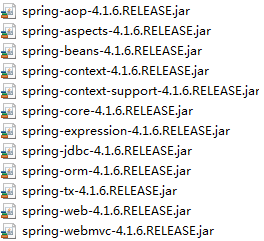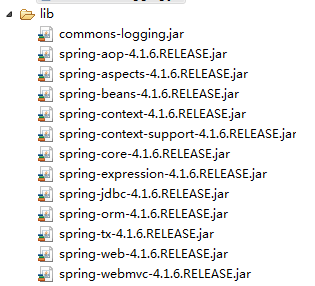Spring学习笔记--Spring IOC
沿着我们上一篇的学习笔记,我们继续通过代码学习IOC这一设计思想.
6.Hello类
第一步:首先创建一个类Hello
package cn.sxt.bean;
public class Hello {
private String name;
public void setName(String name) {
this.name = name;
}
public void show(){
System.out.println("hello,"+name);
}
}
第二步:创建配置文件beans.xml
<?xml version="1.0" encoding="UTF-8"?>
<beans xmlns="http://www.springframework.org/schema/beans"
xmlns:xsi="http://www.w3.org/2001/XMLSchema-instance"
xsi:schemaLocation="http://www.springframework.org/schema/beans
http://www.springframework.org/schema/beans/spring-beans.xsd">
<!-- bean就是java对象,由spring容器来创建和管理 -->
<bean name="hello" class="cn.sxt.bean.Hello">
<property name="name" value="张三"></property>
</bean>
</beans>
第三步:编写测试类Test
package cn.sxt.test; import org.springframework.context.ApplicationContext;
import org.springframework.context.support.ClassPathXmlApplicationContext; import cn.sxt.bean.Hello; public class Test {
public static void main(String[] args) {
//解析beans.xml文件生成管理相应的bean对象
ApplicationContext context=new ClassPathXmlApplicationContext("beans.xml");
Hello hello=(Hello)context.getBean("hello");
hello.show();
}
}
我们需要导入相关Jar包(在上一篇笔记Spring主要内容中显示的那些核心jar包)

此时运行Test程序,会触发异常:Exception in thread "main" java.lang.NoClassDefFoundError: org/apache/commons/logging/LogFactory
我们需要添加commons-logging.jar文件

步骤总结:
1)导入相关jar包
2)编写spring配置文件(名称可以自定义)
思考?
Hello对象是谁创建的?
我们在Hello类中添加一个构造函数,可以确定Hello对象确定被创建:
package cn.sxt.bean;
public class Hello {
public Hello() {
System.out.println("hello 被创建");
}
private String name;
public void setName(String name) {
this.name = name;
}
public void show(){
System.out.println("hello,"+name);
}
}
运行Test测试类结果显示:
hello 被创建
hello,张三
由此可以得知,Hello对象是由spring容器来创建的:bean工厂,可以包含多个bean,创建不同类的对象
<bean name="hello" class="cn.sxt.bean.Hello">
<property name="name" value="张三"></property>
</bean>
Hello对象的属性是怎样设置的?
Hello对象的属性是由spring容器来设置的;
这个过程就叫做控制反转:
控制的内容:指的是谁来控制对象的创建;传统的应用程序,对象的创建是由程序本身来控制,使用Spring以后是由spring来创建对象的。
反转:有反转就有正转,正转指程序来创建对象,反转指程序本身不去创建对象,而变为被动的接收容器给我们创建的对象
总结:以前对象是由程序本身来创建,使用spring后,程序变为了被动接收spring创建好的对象;
控制反转有一个别名--依赖注入(DI-dependency injection)
DI:比如在我们的Hello类中,我们的类Hello就依赖于name属性,以来的这个name属性是由spring容器来设置的,name值的设置过程就叫做依赖注入(通过setName方法进行的依赖注入)
Ioc--是一种编程思想,由主动编程变为别动接收;
Ioc的实现是通过Ioc容器(Bean工厂)来实现的。Ioc容器--BeanFactory
在第一篇学习笔记中的UserDao和UserDaoService的例子,我们在这里就可以使用spring配置文件的方式来管理对象的生命周期以及依赖对象的注入;
beanx.xml修改如下:
<?xml version="1.0" encoding="UTF-8"?>
<beans xmlns="http://www.springframework.org/schema/beans"
xmlns:xsi="http://www.w3.org/2001/XMLSchema-instance"
xsi:schemaLocation="http://www.springframework.org/schema/beans
http://www.springframework.org/schema/beans/spring-beans.xsd">
<!-- bean就是java对象,由spring容器来创建和管理 -->
<bean id="mysqlDao" class="cn.sxt.dao.impl.UserDaoMySqlImpl"></bean>
<bean id="oracleDao" class="cn.sxt.dao.impl.UserDaoOracleImpl"></bean>
<bean id="service" class="cn.sxt.service.impl.UserServiceImpl">
<!-- ref引用对象(对象是由spring来创建的) -->
<property name="userDao" ref="mysqlDao"></property>
</bean>
<!-- property如何设置:name="setUserDao(去除set,并将剩余的UserDao首字母小写)" -->
</beans>
当我们需要替换具体的实现时,就可以直接在配置文件中进行修改,例如将ref="mysqlDao"修改为ref="oracleDao";
在测试类中我们就可以这样来组织代码:
package cn.sxt.test; import org.springframework.context.ApplicationContext;
import org.springframework.context.support.ClassPathXmlApplicationContext; import cn.sxt.service.UserService; public class Test {
public static void main(String[] args) {
ApplicationContext ac=new ClassPathXmlApplicationContext("beans.xml");
UserService us=(UserService)ac.getBean("service");
us.getUser();
}
}
使用IOC来创建对象的方式:3种方式
1)通过无参的构造方法来创建;
User.java:
package cn.sxt.vo;
public class User {
public User(){
System.out.println("user的无参构造方法");
}
private String name;
public void setName(String name) {
this.name = name;
}
public void show(){
System.out.println("name="+name);
}
}
beans.xml:
<?xml version="1.0" encoding="UTF-8"?>
<beans xmlns="http://www.springframework.org/schema/beans"
xmlns:xsi="http://www.w3.org/2001/XMLSchema-instance"
xsi:schemaLocation="http://www.springframework.org/schema/beans
http://www.springframework.org/schema/beans/spring-beans.xsd">
<bean id="user" class="cn.sxt.vo.User">
<property name="name" value="张三"></property>
</bean>
</beans>
Test:
package cn.sxt.test; import org.springframework.context.ApplicationContext;
import org.springframework.context.support.ClassPathXmlApplicationContext; import cn.sxt.vo.User; public class Test { public static void main(String[] args) {
ApplicationContext ac=new ClassPathXmlApplicationContext("beans.xml");
User user=(User)ac.getBean("user");
user.show();
} }
2)通过有参构造方法来创建;
User.java:
package cn.sxt.vo;
public class User {
private String name;
public User(String name) {
super();
this.name = name;
}
public void show(){
System.out.println("name="+name);
}
}
beans.xml配置(有三种情况):
第一种:根据参数的下标(index)来设置;
<?xml version="1.0" encoding="UTF-8"?>
<beans xmlns="http://www.springframework.org/schema/beans"
xmlns:xsi="http://www.w3.org/2001/XMLSchema-instance"
xsi:schemaLocation="http://www.springframework.org/schema/beans
http://www.springframework.org/schema/beans/spring-beans.xsd">
<bean id="user" class="cn.sxt.vo.User">
<!-- index指的是构造方法参数下标,从0开始 -->
<constructor-arg index="0" value="李四"></constructor-arg>
</bean>
</beans>
第二种:根据参数名称(name)来设置;
<bean id="user" class="cn.sxt.vo.User">
<!-- name指的是属性值 -->
<constructor-arg name="name" value="王五"></constructor-arg>
</bean>
第三种:根据参数类型(type)来设置;
<bean id="user" class="cn.sxt.vo.User">
<constructor-arg type="java.lang.String" value="徐六"></constructor-arg>
</bean>
3)通过工厂方法来创建对象(有两种);
第一种:静态工厂来创建;
UserFactory.java:
package cn.sxt.factory;
import cn.sxt.vo.User;
public class UserFactory {
public static User newInstance(String name){
return new User(name);
}
}
beans.xml配置:
<bean id="user" class="cn.sxt.factory.UserFactory" factory-method="newInstance">
<constructor-arg index="0" value="任七"></constructor-arg>
</bean>
第二种:动态工厂来创建
UserDynamicFacory.java:
package cn.sxt.factory;
import cn.sxt.vo.User;
public class UserDynamicFactory {
public User newInstance(String name){
return new User(name);
}
}
beans.xml:
<bean id="userFacotry" class="cn.sxt.factory.UserDynamicFactory"/>
<bean id="user" factory-bean="userFacotry" factory-method="newInstance">
<constructor-arg index="0" value="王五"/>
</bean>
Spring学习笔记--Spring IOC的更多相关文章
- Spring学习笔记--spring+mybatis集成
前言: 技术的发展, 真的是日新月异. 作为javaer, 都不约而同地抛弃裸写jdbc代码, 而用各种持久化框架. 从hibernate, Spring的JDBCTemplate, 到ibatis, ...
- Spring学习笔记--Spring配置文件和依赖注入
Spring配置文件 1.alias:设置别名,为bean设置别名,并且可以设置多个别名; <!-- 设置别名 --> <alias name="user" al ...
- Spring学习笔记—Spring之旅
1.Spring简介 Spring是一个开源框架,最早由Rod Johnson创建,并在<Expert One-on-One:J2EE Design and Development> ...
- Spring学习笔记1——IOC: 尽量使用注解以及java代码(转)
在实战中学习Spring,本系列的最终目的是完成一个实现用户注册登录功能的项目. 预想的基本流程如下: 1.用户网站注册,填写用户名.密码.email.手机号信息,后台存入数据库后返回ok.(学习IO ...
- Spring学习笔记1——IOC: 尽量使用注解以及java代码
在实战中学习Spring,本系列的最终目的是完成一个实现用户注册登录功能的项目. 预想的基本流程如下: 1.用户网站注册,填写用户名.密码.email.手机号信息,后台存入数据库后返回ok.(学习IO ...
- spring学习笔记之---IOC和DI
IOC和DI (一)IOC (1) 概念 IOC (Inverse of Control) 反转控制,就是将原本在程序中手动创建对象的控制权,交给spring框架管理.简单的说,就是创建对象控制权被反 ...
- Spring学习笔记——Spring中的BeanFactory与FactoryBean
BeanFactory BeanFactory是Spring的org.springframework.beans.factory下的一个接口,是Spring IOC所遵守的基本编程规范.他的实现类有D ...
- Spring学习笔记--Spring简介
1.spring:给软件行业带来了春天; 2.spring的理念:spring框架的初衷是使的现有的更加实用,spring不是创造轮子(技术或框架),而是使现有的轮子更好的运转;spring本身是一个 ...
- Spring学习笔记——Spring中lazy-init与abstract具体解释
Spring的懒载入的作用是为了避免无谓的性能开销,就是当真正须要数据的时候才去运行数据的载入操作.不只在Spring中.我们在实际的编码过程中也应该借鉴这种思想,来提高我们程序的效率. 首先我们看一 ...
随机推荐
- useradd 命令的常见用法
在Linux系统中 useradd 是个很基本的命令,但是使用起来却很不直观.以至于在 Ubuntu 中居然添加了一个 adduser 命令来简化添加用户的操作.本文主要描述笔者在学习使用 usera ...
- 2D游戏新手引导点光源和类迷雾实现
一.新手引导须要的遮罩效果 一般做新手引导的时候,会把游戏画面变的半黑,然后须要玩家点击的地方就亮起来.经常使用的做法是採用遮罩来实现,可是仅仅能实现方形的,不能不规则图形.以及是全然挖空.做不到渐变 ...
- android makefile文件批量拷贝文件的方法
该方法是shell 和makefile组合使用 wallpapers := $(shell ls packages/apps/hyst_apps/NewBingoLauncher_C/default_ ...
- 各种软件的安装教程centos mysql tomcat nginx jenkins jira 等等
464 Star3,606 Fork 1,460 judasn/Linux-Tutorial 作者: https://github.com/judasn Linux-Tutorial/markdow ...
- 当 Visual Studio 扩展遇到错误时
我是遇到了 Github 扩展经常在 Visual Studio 启动时报错,找了一下可以尝试以下方法: 首先卸载插件 然后删除 %LocalAppData%\Microsoft\VisualStud ...
- 转发-基于ASP.NET MVC 4/5 Razor的模块化/插件式架构实现
基于ASP.NET MVC 4/5 Razor的模块化/插件式架构实现 概述 在日常开发中, 我们经常谈起模块化/插件化架构,这样可既可以提高开效率,又可以实现良好的扩展性,尤其对于产品化的系统有 ...
- SSH免登录及原理
1.免登陆实现 1)在本机生成公钥/私钥对 ssh-keygen 执行成功后,在.ssh文件夹下,会多出两个文件 id_rsa和id_rsa.pub 2)将公钥写入远端服务器.ssh文件夹下的auth ...
- linux每日命令(8):mv命令
mv命令是move的缩写,可以用来移动文件或者将文件改名(move (rename) files),是Linux系统下常用的命令,经常用来备份文件或者目录. 一.命令格式: mv [选项] 源文件或目 ...
- [C++]Qt文本操作(按行读写)
资料来源:https://blog.csdn.net/flyfish1986/article/details/79487104 #include <QDebug> #include < ...
- Future 模式简介
简介 Future 模式是多线程开发中的一种常见设计模式,它的核心思想是异步调用. 比如我们在网上购物,付款后就会产生一个订单,之后你该干嘛干嘛,快递小哥会上门送货,而不必像在超市结账那样,付款后要等 ...
